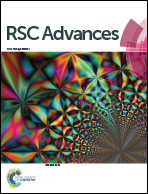Design and synthesis of periodic mesoporous organosilica materials with a multi-compartment structure†
Abstract
Recently many scientists are interested in replicating the unique structure and function of multi-compartments found in natural cells. Despite the success in recreating multi-compartment structures for organic materials, it is a great challenge to translate a similar concept into inorganic and hybrid materials for more versatile applications. Here, as the first example in the organosilica family, we present a facile synthesis route to create hybrid materials with a multi-compartment structure through the spontaneous assembly of fluorocarbon (FC) and hydrocarbon (HC) surfactants with the addition of co-solvent. The formation of multi-compartment periodic mesoporous organosilica (MCPMO) is triggered by the presence of organic co-solvent that induces an osmotic pressure difference in the system. The MCPMO demonstrates a high loading capacity of the antimalarial and anticancer drug artemisinin (47%) with a sustainable release profile attributed to the unique compartmentalized structure and hydrophobic properties. This synthesis strategy can be extended to design various materials with different compositions and morphologies for wider applications including microelectronics, biomedicine, catalysis and energy storage.


 Please wait while we load your content...
Please wait while we load your content...